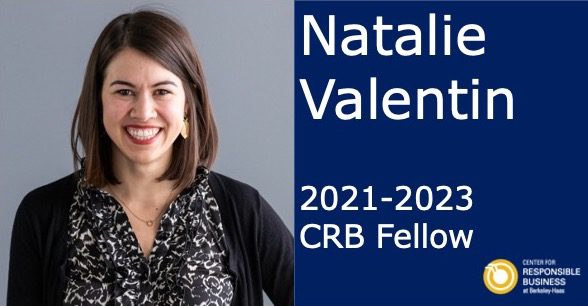A 29-year old’s take on the 29th Annual SRI Conference

Written by: Michelle Levinson, ERG/MPP ’19
In the aftermath of another round of divisive elections in the United States (and around the globe) many of us feel distraught about the ability and speed of our political systems to address urgent social challenges. Political change requires organizing and community–slow but necessary processes. Meanwhile, from climate change to income inequality, gentrification and displacement to the gender-wage gap, the challenges we face as a society seem more acute than ever.
Votes may have been cast and ballots counted, but that does not mean we must wait another two years for our next chance to shape our world. Any month of any year, we can vote with our investment dollars. Directly or indirectly, through our educational institutions, pension and retirement funds, and city treasuries, we are all investors in the global economy. But where do we direct this capital? To whom do we entrust it to be used well, and to build a foundation for our long-term personal and communal well-being? We are stakeholders in the economic system, but many of us do not wield this power with as much purpose as we could.
Last week I was lucky enough to attend the SRI Conference in Colorado Springs as one of 12 conference scholars. I met people that have spent decades wrestling to spread awareness and develop the tools to direct the power of investments towards social ends. Individual retirement advisors, endowments for religious orders, the City of Chicago, the Sierra Club Foundation–socially responsible investing (SRI) is being practiced throughout the investment industry. The principle is straightforward: when we own a piece of a company, whether in the public markets, as debt, or as private equity, we are reducing that company’s cost of capital. In a way, we are “betting” that a company’s business model, practices, and products will contribute to a better, more prosperous world in the future.
As students of economics, we also know that there are plenty of instances where corporate profit maximization can be misaligned with socially optimal outcomes, especially when those internalized benefits create externalized costs. In these cases, a rational business decision or practice that we are facilitating through our investments might run counter to our own long-term priorities and needs. A classic example comes from the tobacco industry, where healthcare costs that result from tobacco externalities are in part borne by society as a whole. This reasoning undergirds decisions like the famed move by CalPERS to divest from tobacco, even where this means foregoing internalized profits. The question is simple in the eyes of former California Treasurer Phil Angelides: “What sense does it make for CalPERS to be an investor in companies that cost the state billions of dollars?” (LA Times, 12/14/16).
Avoiding negative externalities is a start, but investors are increasingly aiming to finance positive impacts. At this conference, Chicago City Treasurer Kurt Summers shared that his office sees its investment dollars as a way to “make a positive impact on some of the most fundamental challenges facing Chicagoans.” Considering environmental, social, and governance (ESG) factors help his office promote conservation and sustainability, racial and gender equity, better labor standards and more, all of which improve the quality of life for both the current and future Chicago community.
By definition, these negative externalities and positive impacts are not captured in traditional financial information. However, the finance industry is awakening to the notion that non-financial information can be material to a company’s economic performance. This is illustrated by the groundbreaking work of Sustainability Accounting Standards Board (SASB) and the Task Force on Climate-related Financial Disclosures (TCFD), which are setting standards for sustainability disclosures across industries and asset classes. And this notion is not new! SRI strategies have been developed and refined over decades, evidenced by the fact that this year’s conference was the 29th reunion of these industry practitioners.
As with anything that has endured for over a quarter-century (including myself), growth and adaptation are paramount in a changing world. Long-time conference attendees noted the dramatic shift of SRI from a niche pursuit addressed by specialists to a principal component of the financial industry that mainstream entities like BlackRock are looking to embrace. This is happening simultaneously with an increase in the sophistication of responsible investing strategies. There are still many firms that enable investors to simply eliminate undesirable industries from their portfolios, such as with a Catholic values screen. However, many investment firms were eager to showcase proprietary approaches to integrating ESG information into investment decision-making and novel models to create positive impact with investment dollars. The SRI Conference demonstrated that there are plenty of ways to shift capital to better align it with investor values and long-term needs, and that this approach is gaining steam.
But shifting capital is not the only way that investors are looking to bring ESG considerations into their investing practice. Another tool that is extremely important to the SRI community is shareholder engagement, where investors use formal or informal mechanisms to influence business decisionmaking. Conversations around the need to defend and refine shareholder engagement mechanisms were front and center, especially in light of the Security and Exchange Commission’s (SEC) Staff Roundtable on the Proxy Process. SEC Commissioner Robert Jackson shared insights and called on the audience to meet with SEC Commissioners and explain their needs and philosophies as SRI investors. When I caught up with the Commissioner during a coffee break I asked about enforcement of the SEC’s 2010 interpretive guidance around climate change disclosures. True to form, Commissioner Jackson encouraged me to submit a petition to and connect directly with the SEC staff.
This year’s 29th SRI Conference provided attendees with a rich snapshot of a dynamic, multifaceted industry. This snapshot illuminated the industry’s shift from niche to mainstream, a growth in asset types and sectors represented, and a welcome intentionality around the diversity of representation and perspectives. These trends ensure that this conference will continue to be a fascinating window into the finance industry and bell-weather for its future. To read more about what you can do to align your personal finances with a future you want to live in, check out Nick Depsky’s great Life@ERG posts on Personal Banking and Retirement Accounts + Mutual Funds.
About the Author
 Michelle Levinson
Michelle Levinson
HSRIF Principal 2018-2019
ERG/MPP
Michelle is a concurrent degree student at the Goldman School of Public Policy and the Energy Resources Group. Prior to graduate school, she worked in political, legal, and regulatory advocacy at the Natural Resources Defense Council and NextGen Climate America. Michelle is currently interested in the financial impacts of climate change and economy-wide decarbonization.


